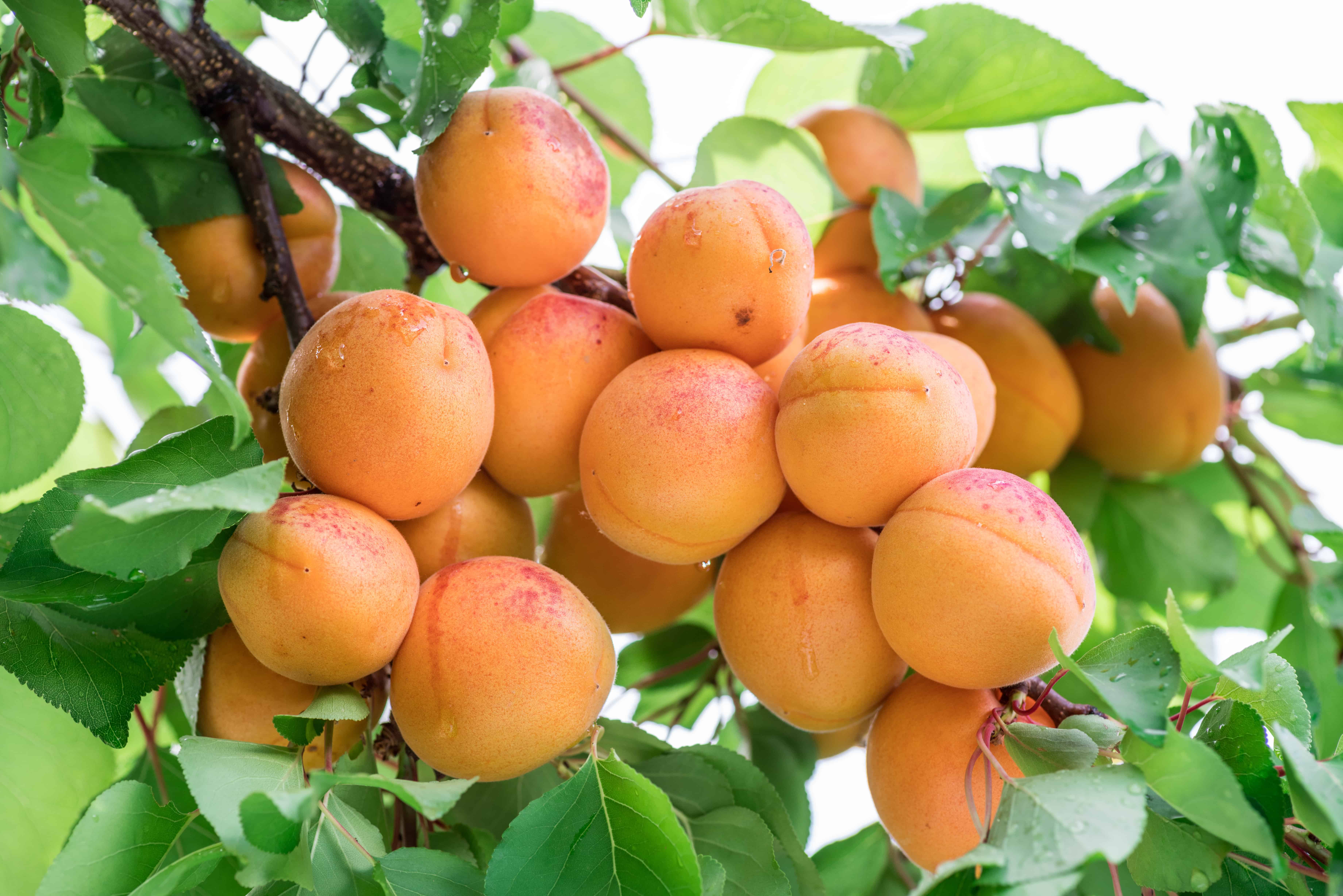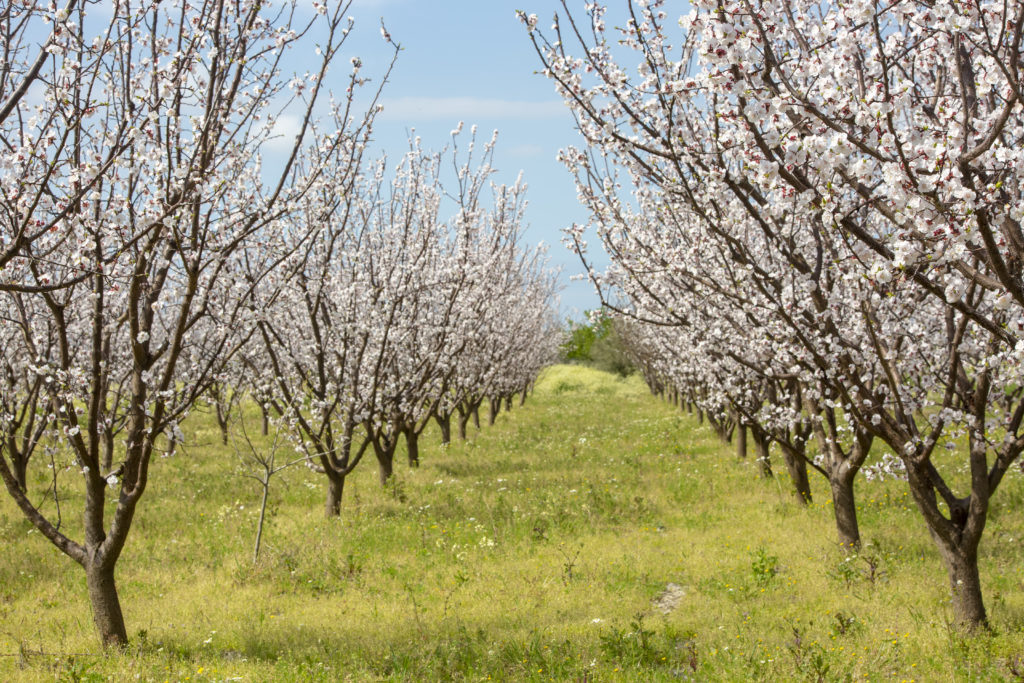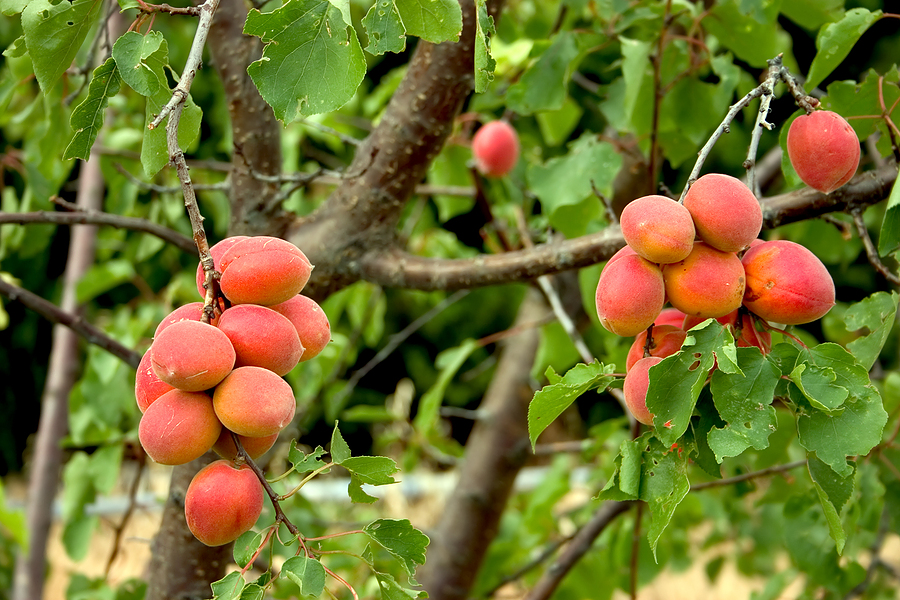The apricot is a delectable, sweet fruit. It is the first fruit tree to bloom in spring and the earliest to harvest in summer.
Apricots like moderately cold winters but not late freezes. They like warm summers, but not too hot, and low humidity—very dry weather is good.
Related article:
Apricots are the sweetest when ripened on the tree. That makes them difficult to grow and ship; harvested too early they are bland.
For golden orange or red-blushed, sweet, and juicy apricots it’s best to grow your own.
Here is your complete guide to growing apricot trees.
Good Products to Control Animal Pests at Amazon:
- Live Trap for Large Garden Pest Animals
- Electric Fence/Netting for Garden Protection
- Garlic Barrier Spray to Repel Animals
- Scarecrow Fake Owl for Garden Protection
- Motion Activated Sprinkler to Deter Animals
Best climate to grow an apricot tree
- Apricots grow best in Zones 5 to 9. Select a cultivar that grows well in your area. Contact the nearby Cooperative Extension Service for recommendations.
- Apricots need a climate where winter is cold enough to provide a period of dormancy. They need 600 to 900 chill hours (32 to 45°F) each year, fewer chill hours than a peach, but they will not survive temperatures below 0° Conversely, they are not well adapted to summer heat much above 100°F.
Where to plant an apricot tree
- Apricots are the first fruit trees to bloom early in spring; planting apricots where frost comes late in spring is risky. Frost will kill flower buds and blossoms.
- In regions with a late spring, plant apricots on the north side of a building so they remain dormant longer and bloom later.
- In cool summer regions, fan train apricots against a south or southwest fence or wall or grow them in containers in a greenhouse or sunroom.
- Plant apricots in full sun. They can grow in partial shade, but the yield will be less than if grown in full sun.
- Plant apricots in well-drained loamy soil. Apricots do not like wet roots.
- Apricots grow best in neutral or slightly alkaline soil with a soil pH range of 6.7 to 7.5.
- Avoid planting apricots where there is a prevailing breeze or in low spots that can collect frost.

How to plant an apricot tree
- Apricots can be purchased bare-root, baled-and-burlapped, or container-grown.
- Plant bare-root trees in early spring as soon as the soil can be worked and while the trees are still dormant. Plant balled-and-burlapped or container-grown trees in spring or early summer before hot, dry weather comes, or wait and plant later in fall.
- Prepare a planting site in full sun that is sheltered from a prevailing breeze or wind.
- Work well-rotted compost or manure into the soil and add a cupful of all-purpose fertilizer to the bottom of the hole.
- Dig a hole half again as deep and twice as wide as the tree’s roots.
- Put a tree stake (or support wires for a fan) in place before planting. Drive the stake into the ground to the side of the hole to at least 2 feet deep.
- Set the tree in the hole so that the soil mark on the stem is at the surface level of the surrounding soil. (Remove all twine and burlap from balled and burlapped trees.) Spread the roots out in all directions.
- Re-fill the hole with half native soil and half aged compost or commercial organic planting mix; firm in the soil so that there are no air pockets among the roots. Water in the soil and create a modest soil basin around the trunk to hold water at watering time.
- Secure the tree to the stake with tree ties.
- After planting, water each tree thoroughly and fertilize it with a high-phosphorus liquid starter fertilizer.
Spacing apricot trees
- A standard full-size apricot can grow from 20 to 30 feet tall. Space standard varieties 20 to 25 feet apart.
- Dwarf apricots can be from 12 to 15 feet tall; space dwarf trees 12 to 15 feet apart.

Apricot tree pollination
- Most apricots are self-fertile and will produce fruit if planted alone. ‘Riland’ and ‘Perfection’ are the only varieties that are not self-fruitful; they require another apricot within 300 feet.
- Planting two cultivars near one another allowing for cross-pollination will increase the yield of each tree.
Apricot tree yield
- A full-size apricot can produce 150 to 200 pounds of fruit per year.
- A dwarf variety will produce 50 to 100 pounds of fruit per year.
Container growing an apricot tree
- Dwarf apricot trees can be grown in containers.
- Choose a large pot or tub at least 18 inches wide and deep that is well-drained.
- Plant trees in a commercial organic potting mix.
- Keep the soil evenly moist but not wet.
- Feed apricots growing in containers with an all-purpose fertilizer that is slightly higher in potassium. Apply a liquid fertilizer in spring and summer.
- Top-dress plants in containers once a year with fresh potting soil.
- Repot the tree after two years into a container that is 24 inches wide and deep.
- Protect apricots in containers from frost by covering them with a heavy row cover or moving them indoors.
Apricot tree care, nutrients, and water
- The first summer after planting, water apricot trees weekly. Once the tree is established it will need only infrequent watering. Keep the soil evenly moist during the time fruits are swelling so that they reach full size.
- Test irrigation water to make sure it is not high in salt, boron, or chlorine.
- Feed trees in early spring; spread several inches of aged compost or aged manure around each tree out to the drip line. Also, in spring, feed trees with an all-purpose (10-10-10) fertilizer before fruit sets.
- If tree growth is slow test the soil for nutrient deficiencies. If growth is vigorous and overly lush; plant a cover crop around trees to use up some of the extra soil nitrogen.
- Apricots flower early in spring; commonly before peaches and nectarines. Buds and flowers must be protected from frost. Place a floating row cover over plants when frost is predicted. Remove the cover during the day.
Training an apricot tree
- Train tall, standard apricot varieties to an open-center structure. In cold climates, train apricots to a modified central leader.
- Train upright-growing dwarf apricots with a central leader.
Pruning an apricot tree
- Apricots bear fruit both on shoots and stem that grew last year and on clusters or older fruiting spurs.
- Thin out old lateral stems and branches and sub-laterals that no longer bear fruit. This will give fruit-bearing young branches and spurs plenty of sun and space for growth and fruiting.
- Prune to remove all diseased, dead, and broken branches. Remove fast-growing vertical branches called water sprouts. Remove shoots that grow from the root below the soil, called suckers. Remove crossing and rubbing branches that can injure each other. Remove V-branching branches, called crotches; narrow crotch branches cannot support the weight of fruit.
- Do not prune more than one-third of the total tree each year.
- Prune to just above a growth bud or flush to a main branch or trunk.
- Prune in dry summer weather when diseases are dormant. Apricots are more susceptible to bacterial canker when pruned in winter; the disease can enter the plant through pruning cuts.
Thinning apricot trees
- Thin apricots when fruits are marble size. Thin fruits to leave 2 to 3 inches between fruits.
- Trees that are not thinned and set excessive fruit may set little or no fruit the following year.
Propagating apricots trees
- Apricots are propagated by bud grafting. The fruiting portion of the tree is grafted to a root system suitable for regional growth.

Harvesting apricots
- Apricots begin to fruit two to four years after planting.
- The apricot harvest occurs mid to late summer.
- A single tree will ripen its fruit over a period of about three weeks.
- To determine if the fruit is ready for picking, cup the fruit in your hand and give it a gentle twist; if it pulls away easily leaving the stalk behind it is ripe. A ripe apricot will be slightly soft and sweet tasting.
- Let apricots ripen on the tree as long as possible.
Storing apricots
- Fruit can be refrigerated for one to two weeks.
- Apricots can be frozen, canned, or dried. To freeze the fruit first remove the stone. Pick apricots firm-ripe if you plan to can or freeze the fruit.
- Seeds of the apricot variety ‘Sweetheart’ can be eaten like almonds; the seed of most cultivars is not edible.
Apricot tree pests
- Birds will eat buds in winter and ripen fruit in summer. Net trees to keep birds away. Small trees can be protected by a net cage.
- Spider mites can cause leaves to become mottled and discolored; fine silk webbing will be seen on the undersides of leaves. Spray leaves with summer oil to smother mites.
- Codling moth larvae can chew small holes in leaves; the holes will be surrounded by black excrement. In late spring place pheromone traps to attract and trap male moths to prevent mating. Trap larvae in sticky tree bands.
- Oriental fruit moth larvae burrow into the tips of shoots causing them to wilt; the larvae may tunnel into the fruit. Spray plants with summer oil to kill eggs and larvae.
- Scale are elliptical, hard-shelled insects that feed on stems and branches. Spray with oil-based dormant spray in winter to smother the insects; spray with summer oil in summer.
- Peachtree borer larvae tunnel through the inner bark disrupting the flow of water and nutrients. Probe the entry hole with a wire to kill the borer.
Apricot tree diseases
- Bacterial leaf spot can cause dark spots or shot holes on leaves and early leaf drop. Collect and dispose of diseased leaves. The next spring spray swelling buds with lime-sulfur every 1 to 3 weeks in wet or humid weather.
- Bacterial canker causes bark or stems to ooze orange resin or gum. Oozing gum may also indicate blunt injury to the wood. Prune away all infected wood and dispose of it in the trash.
- Brown rot is a fungal disease that causes soft, brown, fuzzy mold patches on fruit; spray trees with lime-sulfur when buds begin to turn green in spring; during bloom spray trees with sulfur if the weather is humid, rainy, or above 70° Brown rot can also cause leaves and blossoms to turn brown.
- Shothole is a fungal disease that causes small brown-red spots on leaves; the centers of the spots decay and fall out; remove and destroy infected disease. Spray with copper spray.
- The Dieback of young shoots and stems is caused by a fungal disease. The shoots wilt, turn brown and die. Cut off and destroy infected foliage and branches.
Fall and winter apricot tree care
- Prune in summer or complete pruning in fall before the dormant period begins.
Apricot tree varieties to grow
Recommended varieties: ‘Autumn Royal’, ‘Chinese’, ‘Earligold’, ‘Flora Gold’, ‘Garden Anne’, ‘Gold Kist’, ‘Goldcot’, ‘Golden Amber’, ‘Goldenglo’ (good in containers), ‘Goldfinch’, ‘Harglow’ (late blooming), ‘Katy’ (good choice in Zones 7-9), ‘Moorpark’ (good choice in zone 4), ‘Newcastle’, ‘Perfection’ (not self-fertile), ‘Plum Parfai’t, ‘Riland’, ‘Rival’, ‘Royal’ (‘Blenheim’), ‘Royal Rosa’, ‘Sundrop’ (not self-fertile), ‘Sweetheart’ (good choice in Zones 5-8), ‘Tilton’ (good for drying), ‘Wenatchee Moorpark’.
Apricot varieties by harvest time
The apricot harvest can be divided into early, mid-season, and late. That means you can enjoy some or all of these over the course of the apricot harvest.
- Aprium: medium to large fruit with clear yellow skin and some plum taste. Late harvest.
- August Glo: medium-size apricot with a great sweet-tart flavor. Late harvest.
- Autumn Royal: similar to Blenheim; medium fruit with yellow skin with a slight orange blush; the flesh is yellow, slightly acid. Use fresh, canned, or dried. Late harvest into fall.
- Blenheim: medium to large apricot with thick yellow-orange flesh, very juicy fruit with sweet, sprightly, and aromatic flavor. This is the classic California apricot. Eat out of hand or use for canning. Early to midseason harvest.
- Chinese (Mormon): small, orange-skinned fruit with red blush. Smooth, firm flesh is sweet and juicy. Midseason to late harvest.
- Earligold: medium-sized fruit is golden yellow with rich and juicy flesh. Use for canning and for eating fresh. Early harvest.
- Floragold: small to medium size apricot with yellow skin and flesh. Mid-season harvest.
- Garden Annie: medium to large fruit with a bright yellow skin; the clingstone flesh is juicy and firm. Early harvest.
- Gold Kist: medium to large apricot with red-blushed yellow skin. Excellent sweet-tart flavor. Use for canning, freezing, drying, and eating fresh. Early harvest.
- Goldcot: medium too large fruit nearly round with bright gold skin; thick flesh is orange and firm and sprightly-sweet flavored. Use for processing, canning, or eating fresh. Midseason to late harvest.
- Golden Amber: large and symmetrical apricot with yellow skin and flesh, firm, slightly acid. Use fresh, in canning, or for drying. Late harvest.
- Harcot: medium to large fruit, firm, sweet, and juicy. Early harvest.
- Harglow: medium-sized orange apricot, sometimes blushed red; firm, sweet, and flavorful. Early harvest.
- Hargrand: very large, firm apricot. Midseason harvest.
- Harogem: good flavor. Late harvest.
- Katy: large apricot with red-blushed skin and deep yellow flesh; freestone flesh is firm mild and sweet. Early harvest.
- King: very large apricot. Midseason harvest.
- Manchurian apricot: small, mild-flavored, orange fruit. Use for drying. Early harvest.
- Montrose: large apricot with yellow skin and red blush; sweet, juicy great flavor; edible kernel. Late harvest.
- Moongold: plum-size apricot with golden skin and flesh; sweet, sprightly flavor. Use fresh, canned or for jam. Early to midseason harvest.
- Moorpark: this large apricot was developed in the eighteenth century. Considered one of the best. Juicy and aromatic; sweet rich, plum-like taste. Brownish-red skin with specks and dots; yellow to orange flesh. Midseason harvest.
- Newcastle: small to medium round well-shaped apricot with lemon-yellow skin; the flesh can be soft and coarse. Midseason harvest.
- Perfection (Goldbeck): fruit is large, oval to oblong, light yellow–orange skin with a pebbly appearance; yellow to yellow-orange flesh; mediocre flavor. Early harvest.
- Plum Parfait: medium fruit; skin is red blushed over dark yellow; the flesh is dark yellow marbled red at the pit. This is a hybrid of Japanese plum and apricot. Early harvest.
- Puget Gold: medium-size apricot with good flavor and low in acid. Use canned or dried. Mid- to late-season harvest.
- Riland: nearly round, medium fruit is covered with fine velvety hairs; light yellow skin has deep red blush over half of the fruit; the flesh is firm and meaty. Ripens from the pit out. Midseason harvest.
- Rival: large, oval orange apricot blushed red. Early harvest.
- Royal Rosa: medium fruit with bright yellow skin; firm flesh has a pleasant aroma; the flavor is a good balance between sugar and acid. Best for eating fresh. Midseason to late harvest.
- Royalty: extra-large apricot. Early harvest.
- Stark Tilton:
- Sungold: plum-size, bright orange apricot with a sweet, mild flavor. Use fresh, canned, or jam. Early to midseason harvest.
- Sun-Glow: very colorful fruit. Midseason harvest.
- Tilton: large to very large apricot with orange skin yellow-orange flesh; fair flavor. Use fresh. Midseason harvest.
- Tomcot: Large, sweet fruit with sweet orange flesh. Early harvest.
- Wenatchee Moorpark: Large to oval apricot with orange-yellow flesh and skin; fair texture. Excellent flavor. Midseason harvest.
Also of interest:
Garden Planning Books at Amazon:
- Vegetable Garden Almanac & Planner
- Kitchen Garden Grower’s Guide Vegetable Encyclopedia
- Vegetable Garden Grower’s Guide
- Tomato Grower’s Answer Book
More fruit-growing articles:
Learn how to plant, grow, prune, and harvest your favorite fruits. Click below for all you need to know.
- Apple
- Apricot
- Avocado
- Banana
- Blackberry
- Blueberry
- Cantaloupe
- Chayote
- Cherimoya
- Cherry
- Citrus
- Clementine
- Cranberry
- Currants
- Elderberry
- Feijoa
- Fig
- Gooseberry
- Grape
- Grapefruit
- Guava
- Kiwifruit
- Kumquat
- Lemon
- Lime
- Loquat
- Mandarin
- Mango
- Melon
- Mulberry
- Muskmelon
- Nectarine
- Olive
- Orange
- Papaya
- Passion Fruit
- Peach
- Pear
- Persimmon
- Pineapple
- Pineapple Guava
- Plantain
- Plum
- Pomegranate
- Pumpkin
- Quince
- Raspberry
- Strawberry
- Tangelo
- Tangerine
- Tangor
- Watermelon















